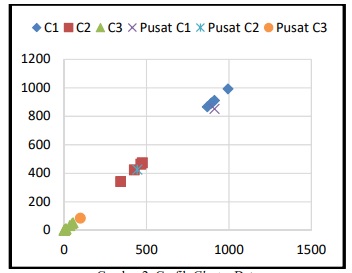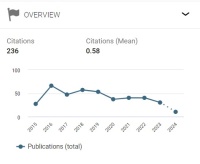Clustering History Data Penjualan Menggunakan Algoritma K-Means
Abstract
The company has a desire to develop an increase in its business so that it is not eroded by the very tight business competition. PT. Baliyoni Saguna is a company engaged in information technology and telecommunications which currently helps its customers to provide the best solutions according to customer needs. Product quality is a major factor in keeping customers alive and satisfied with the products provided by PT. Baliyoni Saguna. These products need to be reviewed in order to have a reference in creating the best products. Clustering is a method that can be used to see the level of sales that have been made based on the formed clusters. The K-Means algorithm is a method capable of processing sales history data owned by PT. Baliyoni Saguna in forming groups according to the item category of the item. The K-Means algorithm is able to provide convenience in processing large data so that it can be processed more quickly and efficiently. The results of the application of the K-Means algorithm formed 3 clusters representing the most desirable, least desirable, and least desirable categories. In the most desirable category there are 5 total items, 4 in the interested category there are 4 total items, and 14 items less desirable. These results are expected to help in creating quality goods so as to maintain product quality and customer satisfaction.
Keywords – Clustering, K-Means Algorithm, PT. Baliyoni Saguna
Downloads
References
[2] A. Primandana, S. Adinugroho, and C. Dewi, “Optimasi Penentuan Centroid pada Algoritme K-Means Menggunakan Algoritme Pillar (Studi Kasus: Penyandang Masalah Kesejahteraan Sosial di Provinsi …,” … Teknol. Inf. dan Ilmu …, vol. 3, no. 11, pp. 10678–10683, 2020, [Online]. Available: http://j-ptiik.ub.ac.id/index.php/j-ptiik/article/download/6748/3264.
[3] A. W. Oktavia Gama, I. K. Gede Darma Putra, and I. P. Agung Bayupati, “Implementasi Algoritma Apriori Untuk Menemukan Frequent Itemset Dalam Keranjang Belanja,” Maj. Ilm. Teknol. Elektro, vol. 15, no. 2, pp. 21–26, 2016, doi: 10.24843/mite.1502.04.
[4] S. S. Nagari and L. Inayati, “Implementation of Clustering Using K-Means Method To Determine Nutritional Status,” J. Biometrika dan Kependud., vol. 9, no. 1, p. 62, 2020, doi: 10.20473/jbk.v9i1.2020.62-68.
[5] S. Saefudin and D. Fernando, “Penerapan Data Mining Rekomendasi Buku Menggunakan Algoritma Apriori,” JSiI (Jurnal Sist. Informasi), vol. 7, no. 1, p. 50, 2020, doi: 10.30656/jsii.v7i1.1899.
[6] I. Parlina, W. Agus Perdana, W. Anjar, and L. M.Ridwan, “Memanfaatkan Algoritma K-Means Dalam Menentukan Pegawai Yang Layak Mengikuti Asessment Center,” Memanfaatkan Algoritm. K-Means Dalam Menentukan Pegawai Yang Layak Mengikuti Asessment Cent. Untuk Clust. Progr. Sdp, vol. 3, no. 1, pp. 87–93, 2018.
[7] M. S. Mustafa, M. R. Ramadhan, and A. P. Thenata, “Implementasi Data Mining untuk Evaluasi Kinerja Akademik Mahasiswa Menggunakan Algoritma Naive Bayes Classifier,” Creat. Inf. Technol. J., vol. 4, no. 2, p. 151, 2018, doi: 10.24076/citec.2017v4i2.106.
[8] H. Priyatman, F. Sajid, and D. Haldivany, “Klasterisasi Menggunakan Algoritma K-Means Clustering untuk Memprediksi Waktu Kelulusan Mahasiswa,” J. Edukasi dan Penelit. Inform., vol. 5, no. 1, p. 62, 2019, doi: 10.26418/jp.v5i1.29611.
[9] I. S. Melati, L. Linawati, and I. A. . Giriantari, “Knowledge Discovery Data Akademik Untuk Prediksi Pengunduran Diri Calon Mahasiswa,” Maj. Ilm. Teknol. Elektro, vol. 17, no. 3, p. 325, 2018, doi: 10.24843/mite.2018.v17i03.p04.
[10] E. Ainun, W. Isti, and S. Fachri, “Implementasi Algoritma K - Means Clustering Tingkat Kepentingan Tagihan Rumah Sakit Di Pt Pertamina ( Persero ),” 2020.
[11] A. A. G. B. Ariana, I. K. G. Darma Putra, and L. Linawati, “Perbandingan Metode SOM/Kohonen dengan ART 2 pada Data Mining Perusahaan Retail,” Maj. Ilm. Teknol. Elektro, vol. 16, no. 2, p. 55, 2017, doi: 10.24843/mite.2017.v16i02p10.
[12] M. Pasek, A. Ariawan, N. P. Sastra, and I. M. Sudarma, “K- Mean s Clustering Dan Local Outlier Factor,” vol. 19, no. 1, 2020.
[13] N. G. Yudiarta, M. Sudarma, and W. G. Ariastina, “Penerapan Metode Clustering Text Mining Untuk Pengelompokan Berita Pada Unstructured Textual Data,” Maj. Ilm. Teknol. Elektro, vol. 17, no. 3, p. 339, 2018, doi: 10.24843/mite.2018.v17i03.p06.
[14] S. Butsianto and N. T. Mayangwulan, “Penerapan Data Mining Untuk Prediksi Penjualan Mobil Menggunakan Metode K-Means Clustering,” J. Nas. Komputasi dan Teknol. Inf., vol. 3, no. 3, pp. 187–201, 2020, doi: 10.32672/jnkti.v3i3.2428.
[15] G. Gustientiedina, M. H. Adiya, and Y. Desnelita, “Penerapan Algoritma K-Means Untuk Clustering Data Obat-Obatan,” J. Nas. Teknol. dan Sist. Inf., vol. 5, no. 1, pp. 17–24, 2019, doi: 10.25077/teknosi.v5i1.2019.17-24.
[16] Y. K. Siregar, “Analisis perbandingan algoritma,” vol. 2, no. 1, pp. 151–155, 2019.
[17] A. A. Rismayadi, N. N. Fatonah, dan Erfin Junianto, “Algoritma K-Means Clustering Untuk Menentukan Strategi Pemasaran Di CV. Integreet Konstruksi,” Jurnal Responsif, vol. 3, no. 1, pp. 30–36, 2021, [Online]. Available: http://ejurnal.ars.ac.id/index.php/jti/article/view/393.
[18] O. N. Pratiwi, “Analisa Perbandingan Algoritma K-Means, Decision Tree, Dan Naïve Bayes Untuk Sistem Pengelompokkan Siswa Otomatis,”Jurnal Ilmiah Teknologi Informasi Terapan., vol. II, no. 2, pp. 109–118, 2016.
[19] R. A. M. S. D. Yuhandri, “Perbandingan Algoritma K-Means Clustering Dengan Fuzzy C- Means Dalam Mengukur Tingkat Kepuasan Terhadap Televisi Dakwah Suaru TV,” Jurnal Teknologi dan Sistem Informasi Univrab, vol. 3, no. 1, pp. 10–21, 2018.
[20] M. Y. Rizki, S. Maysaroh, and A. P. Windarto, “Implementasi K-Means Clushtering Dalam Mengelompokkan Minat Membaca Penduduk Menurut Wilayah,” JUST IT Jurnal Sistem Informasi, Teknologi Informasi dan Komputer, vol. 11, no. 2, pp. 41–49, 2021, [Online]. Available: https://jurnal.umj.ac.id/index.php/just-it/article/view/5902.
[21] N. A. S. Damanik, Irianto, dan Dahriansah “Penerapan Metode Clustering Dengan Algoritma K-Means Tindakan Kejahatan Pencurian di Kabupaten Asahan.,”J-Com (Journal of Computer) vol. 1, no. 1, pp. 7–14, 2021, [Online]. Available: http:// jurnal.stmikroyal.ac.id/index.php/j-com


This work is licensed under a Creative Commons Attribution-NonCommercial-NoDerivatives 4.0 International License.

This work is licensed under a Creative Commons Attribution 4.0 International License




